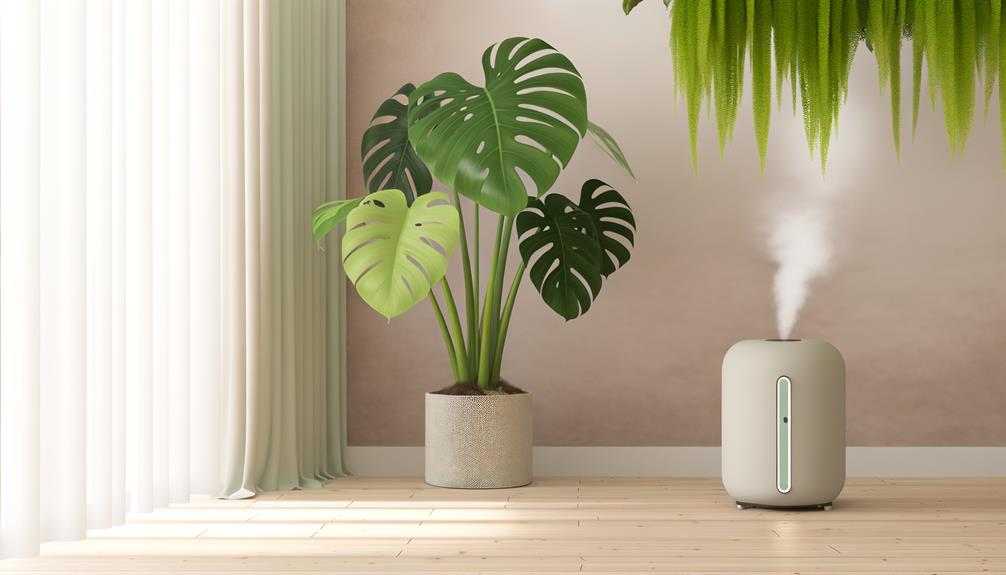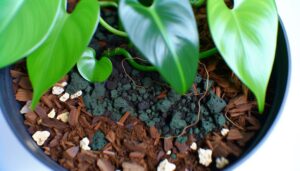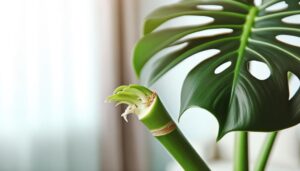How to Keep Variegated Monstera Deliciosa Alive
To keep Variegated Monstera deliciosa (Monstera deliciosa 'Variegata') alive, place it in bright, indirect light and maintain temperatures between 65°F and 80°F. Water weekly during the growing season, ensuring the soil remains moist but not waterlogged; use a well-draining mix enriched with perlite or orchid bark.
Maintain humidity levels between 60% and 80% using a humidifier or pebble tray. Prune with sterilized tools to encourage new growth and prevent infections.
Control pests like spider mites with neem oil. For propagation, root healthy stem cuttings with nodes in water before transferring to soil.
There's more to discover about keeping this beauty thriving.

Key Takeaways
- Ensure it receives bright, indirect light and avoid direct sunlight to prevent leaf damage.
- Maintain soil moisture without waterlogging by watering once a week during the growing season and adjusting as needed.
- Keep humidity levels between 60% and 80% using a humidifier or pebble tray.
- Use a well-draining potting mix rich in organic matter and enhance drainage with perlite or orchid bark.
- Prune regularly with sterilized tools to encourage new growth and remove damaged leaves.
Light Requirements
To maintain your Variegated Monstera deliciosa thriving, make certain it receives bright, indirect light for optimal growth. Direct sunlight can scorch its leaves, leading to chlorophyll degradation and brown patches. Position it near a north or east-facing window, making certain it isn't exposed to intense midday rays.
If natural light is inadequate, use a grow light with a spectrum of 400-700 nm to replicate sunlight. Keep a distance of 12-18 inches between the light source and the plant to prevent overheating. Rotate the plant weekly to guarantee even light distribution and prevent phototropism.
Inadequate light leads to lanky growth and diminished variegation, jeopardizing the aesthetic appeal of Monstera deliciosa var. borsigiana.
Watering Schedule
To maintain your variegated Monstera deliciosa, you need to establish a perfect watering frequency, ensuring the soil remains consistently moist but not waterlogged. Monitor for signs of overwatering, such as yellowing leaves or root rot, and adjust the watering schedule accordingly.
Enhance water drainage by incorporating perlite or orchid bark into your potting mix to prevent excess moisture retention.
Optimal Watering Frequency
Determining the best watering frequency for your variegated Monstera deliciosa (Monstera deliciosa 'Variegata') requires understanding the plant's moisture needs and environmental conditions. Examine the top 2-3 inches of the potting medium; if dry, it's time to water.
During the growing season (spring and summer), you may need to water once a week. However, in dormancy (fall and winter), reduce frequency to every two weeks. Make sure the pot has drainage holes to prevent waterlogging.
Use room-temperature, dechlorinated water and water until you see excess draining out. Monitor humidity levels; Monstera deliciosa 'Variegata' thrives in 60-80% relative humidity. Adjust watering based on indoor conditions, light exposure, and pot size to maintain the best soil moisture.
Signs of Overwatering
Overwatering your variegated Monstera deliciosa can manifest through several key symptoms, including yellowing leaves, root rot, and wilting. To prevent these issues, observe your plant closely. Yellowing leaves often signal chlorosis due to excess moisture. Root rot, caused by fungi like Pythium spp., occurs when roots stay waterlogged, turning them brown and mushy. Wilting despite wet soil indicates stressed root systems unable to absorb nutrients.
| Symptom | Cause | Indication |
|---|---|---|
| Yellowing Leaves | Chlorosis | Excessive moisture disrupting leaf health |
| Root Rot | Fungal infection | Waterlogged roots turning brown/mushy |
| Wilting | Root stress | Soil is wet, but plant appears limp |
Monitor soil moisture levels and adjust your watering schedule accordingly. Frequent watering can be harmful, so make sure the top 2-3 inches of soil dry out between waterings.
Improving Water Drainage
Improving water drainage for your variegated Monstera deliciosa involves selecting a well-draining soil mix, such as one containing perlite or orchid bark, and ensuring the pot has adequate drainage holes. Start by combining equal parts of potting soil, perlite (Perlite), and orchid bark (Orchidaceae). This mixture promotes aeration and prevents waterlogging, essential for Monstera deliciosa.
When potting, place a mesh screen over the drainage holes to prevent soil loss. Water the plant thoroughly, but allow excess water to drain completely. The watering schedule should be consistent; water only when the top 2-3 inches of soil feel dry to touch.
Overwatering can lead to root rot (Phytophthora), so monitor moisture levels regularly with a soil moisture meter for best results.
Humidity Levels
To maintain peak health for your Variegated Monstera deliciosa, it's important to keep the humidity level between 60% and 80%. Regularly monitor humidity with a hygrometer and adjust as needed.
Employ strategies like using a humidifier or placing the plant on a pebble tray to boost humidity.
Ideal Humidity Range
Maintaining an ideal humidity range of 60-80% is essential for the health and vibrancy of your variegated Monstera deliciosa. High humidity levels help Monstera deliciosa var. borsigiana thrive by ensuring optimal transpiration and nutrient uptake.
To achieve this, you can follow these steps:
- Use a humidifier: Place a humidifier near your plant to consistently maintain humidity levels.
- Group plants together: Create a micro-environment by clustering plants, which increases the localized humidity.
- Misting: Regularly mist the leaves with distilled water to boost humidity temporarily.
- Humidity trays: Place the pot on a tray filled with water and pebbles, ensuring the pot's bottom doesn't touch the water directly.
Monitoring Humidity Levels
Accurately monitoring humidity levels is essential for maintaining the variegated Monstera deliciosa (Monstera deliciosa var. borsigiana) in peak health.
First, acquire a digital hygrometer to measure relative humidity (RH) in the plant's environment. Ideal RH should hover between 60-80%, as lower levels can cause leaf browning and reduced variegation.
Place the hygrometer near the Monstera but avoid direct sunlight to guarantee accurate readings. Regularly check the hygrometer, especially during seasonal changes when indoor humidity fluctuates.
If the RH drops below 60%, the plant can experience stress, leading to stunted growth and chlorosis. Consistent monitoring allows you to make timely adjustments, guaranteeing optimal conditions for your variegated Monstera deliciosa.
Boosting Humidity Solutions
When relative humidity consistently falls below the ideal range, employ methods like using a humidifier, grouping plants, or placing the Monstera deliciosa var. borsigiana on a pebble tray to effectively boost moisture levels. Increasing humidity is essential for this aroid's health, as it thrives in environments with 60-80% humidity.
Follow these steps:
- Humidifier: Place a reliable humidifier near the plant to maintain consistent moisture levels.
- Plant Grouping: Cluster your Monstera with other plants to create a micro-humid environment through transpiration.
- Pebble Tray: Set the pot on a tray filled with water and pebbles, ensuring the pot base doesn't touch the water.
- Misting: Mist the leaves regularly with distilled water to mimic natural humidity.
Temperature Needs
Variegated Monstera deliciosa thrives most in temperatures ranging from 65°F to 80°F (18°C to 27°C), ensuring ideal growth and vibrant foliage. To maintain these conditions, monitor room temperature diligently. Avoid placing your Monstera near drafts, air conditioning vents, or heaters, as sudden temperature fluctuations can stress the plant.
Here's a quick reference table to help you maintain the best temperature:
| Temperature Range | Condition | Effect on Plant |
|---|---|---|
| 65°F to 80°F | Best Growth Zone | Healthy, vibrant foliage |
| Below 60°F | Less Than Ideal, Risk of Stress | Slow growth, potential damage |
| Above 85°F | Excessive Heat | Risk of leaf burn, dehydration |
Maintaining these temperatures supports photosynthesis and overall plant health.
Soil Preferences
To ensure your Monstera deliciosa thrives, choose a well-draining potting mix rich in organic matter, like a blend of peat moss, perlite, and orchid bark. This mixture mimics their natural habitat and guarantees proper aeration and moisture retention.
When preparing the soil, make sure the following components are included:
- Peat Moss (Sphagnum spp.): Retains moisture without saturating.
- Perlite (volcanic glass): Improves drainage and prevents soil compaction.
- Orchid Bark (fir bark): Provides structure and enhances air circulation.
- Compost (decomposed organic material): Supplies essential nutrients and enhances soil texture.
These ingredients create an ideal environment for Monstera deliciosa, supporting root health and robust growth. Remember, consistent soil quality is essential for preserving the vibrant variegation in your Monstera.
Fertilizing Tips
Once you've made sure your Monstera deliciosa is planted in the best soil, it's time to provide the necessary nutrients through a consistent fertilizing regimen. Use a balanced, water-soluble fertilizer, such as a 20-20-20 NPK formula, every 4-6 weeks during the growing season. Dilute the fertilizer to half-strength to avoid root burn. Apply the solution directly to the soil, ensuring even distribution around the root zone.
During the dormant winter months, reduce fertilization frequency to every 8-10 weeks. Monitor the plant for signs of nutrient deficiencies, such as yellowing leaves or stunted growth, and adjust the fertilizing schedule accordingly. By following these guidelines, you'll support lush, variegated foliage and robust growth for your Monstera deliciosa.
Pruning Techniques
Regularly pruning your Monstera deliciosa, including the variegated varieties, is essential for maintaining its health and promoting vigorous growth.
To achieve ideal results, follow these precise steps:
- Sterilize Tools: Always use sterilized pruning shears to prevent infections. Dip them in a solution of one part bleach to nine parts water.
- Identify Nodes: Prune just above a node (the point where the leaf meets the stem), ensuring new growth can emerge.
- Remove Damaged Leaves: Cut off yellowing or damaged leaves, focusing on areas with chlorosis or necrosis to redirect energy to healthy parts.
- Control Size: Prune excessively long vines by cutting back to a desirable length, ensuring a balanced and aesthetically pleasing shape.
Pest Control
After ensuring your Monstera deliciosa is properly pruned, focus on managing common pests like spider mites (Tetranychus urticae) and scale insects (Coccoidea) to maintain its health. Inspect the leaves regularly for signs of webbing or small, brown scales. If detected, use a fine spray of neem oil (Azadirachta indica) solution to target affected areas.
Dilute 2 teaspoons of neem oil in a quart of water, adding a few drops of dish soap as an emulsifier. Thoroughly coat the leaves and stems, ensuring you reach the undersides where pests often hide. Repeat this treatment every 7-10 days until the infestation subsides.
Regular monitoring and prompt action will help keep your Monstera deliciosa pest-free and thriving.
Propagation Methods
To propagate your Monstera deliciosa, start by selecting a healthy stem with at least one node and a few aerial roots.
Follow these steps:
- Cut the Stem: Using sterilized pruning shears, make a clean cut just below the node. Make certain the cutting is 4-6 inches long.
- Prepare the Cutting: Remove any leaves near the base to expose the node and aerial roots.
- Root in Water: Place the cutting in a jar of water, making sure the node is submerged. Change the water every few days to prevent stagnation.
- Monitor Root Development: Wait until roots are 2-3 inches long before transferring the cutting to soil. This typically takes 2-4 weeks.
Potting and Repotting
When potting your Variegated Monstera deliciosa, use a well-draining soil mix composed of peat, perlite, and orchid bark to guarantee proper aeration.
Repot every 1-2 years, ideally in the spring, to accommodate growth and prevent root binding.
Monitor the plant's size and root system to decide the need for a larger pot.
Choosing Proper Soil Mix
Choosing the correct soil mix for your Monstera deliciosa variegata is essential to promoting best growth and health. A well-draining, aerated mix supports root function and prevents waterlogging. Aim for a balance of organic matter and inorganic components.
Follow these guidelines for an ideal soil mix:
- Peat Moss: Retains moisture while providing aeration. Use about 30% of the mix.
- Perlite: Enhances drainage and prevents compaction. Incorporate 20% perlite.
- Orchid Bark: Adds structure and mimics natural epiphytic habitats. Include 20%.
- Compost: Enriches soil with nutrients and beneficial microbes. Use 30%.
Regularly check for compactness and refresh the mix to maintain peak conditions. Proper soil mix promotes your variegated Monstera's thriving.
Timing Repotting Properly
Repotting your Monstera deliciosa variegata at the correct time is essential for promoting best growth and preventing root-bound stress. You should repot every 1-2 years, ideally in early spring when the plant's growth phase begins.
Check for signs like roots emerging from drainage holes or stunted growth. Select a container 2-4 inches larger in diameter than the current pot to provide ample space for root expansion. Make sure the new pot has adequate drainage to prevent waterlogging.
Gently remove the plant, loosen the root ball, and prune any dead roots. Position the Monstera in the new pot, fill with a fresh, aerated soil mix, and water thoroughly. This promotes healthy root development and optimal nutrient absorption.
Common Issues
Diagnosing common issues in variegated Monstera deliciosa involves recognizing signs of overwatering, insufficient light, and nutrient deficiencies.
To maintain its health, you must monitor the following:
- Overwatering: Look for yellowing leaves and root rot (Phytophthora spp.). Make sure the soil drains well and let it dry between waterings.
- Insufficient Light: Variegation fades in low light. Place your plant in indirect, bright light to sustain its striking pattern.
- Nutrient Deficiencies: Yellowing leaves and stunted growth indicate a deficiency of nitrogen (N) or magnesium (Mg). Use a balanced, water-soluble fertilizer monthly.
- Pest Infestations: Check for common pests like spider mites (Tetranychus urticae) and scale insects (Coccoidea). Treat with neem oil or insecticidal soap.
Conclusion
Keeping your variegated Monstera deliciosa thriving isn't just rewarding—it's achievable with the right care. Remember, 70% of plant deaths are due to improper watering.
Make sure you provide bright, indirect light, maintain 60-80% humidity, and use well-draining soil. Regularly check for pests and repot when roots outgrow their container.
By following these guidelines, you'll enjoy the unique beauty and air-purifying benefits of your Monstera deliciosa ‘Albo-Variegata' for years to come.






